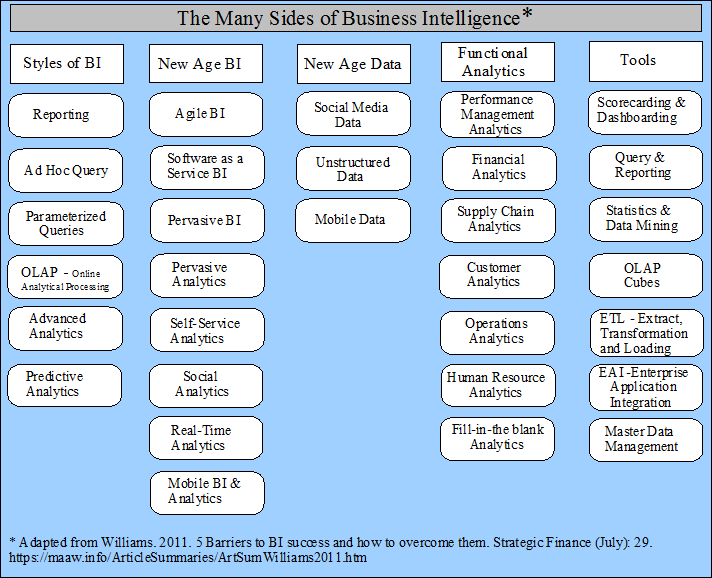
Summary by James R. Martin, Ph.D., CMA
Professor Emeritus, University of South Florida
AIS/MIS Main Page | EIS
& Performance Dashboards Main Page | Software Main Page
The purpose of this paper is to explain why companies have difficulty capturing the benefits of business intelligence. The barriers Williams describes in the paper include the following:
1. Confusing terminology that makes the value of business
intelligence difficult to determine.
2. The mission and importance of business intelligence is unclear.
3. There is no clear link between business intelligence,
business strategy and critical business processes.
4. There is no sense of urgency among top management.
5. Not everyone in the company is on the same page, i.e.,
business strategy, systems and processes, IT strategy and IT operations are not aligned effectively.
My purpose in providing this note is to show some of the terminology associated with business intelligence to provide a brief answer to the question "What is business intelligence?" The following table adapted from Williams Figure 1 is included for that purpose.

From the table it is clear that "Business Intelligence" is a very broad term that includes many concepts, applications and tools. Williams does not define any of the terms in the table above, but the terminology is clearly confusing to those who are not in the information technology business. For more on business intelligence from this author see the following:
Williams, S. 2004. Delivering strategic business value. Strategic Finance (August): 40-48. (Data warehousing and business intelligence technologies).
Williams, S. 2008. Power combination. Strategic Finance (May): 26-35. (The balanced scorecard and business intelligence).
_________________________________________________
Related summaries:
Appelbaum, D., A. Kogan and M. A. Vasarhelyi. 2017. An introduction to data analysis for auditors and accountants. The CPA Journal (February): 32-37. (Summary).
Appelbaum, D., A. Kogan, M. Vasarhelyi and Z. Yan. 2017. Impact of business analytics and enterprise systems on managerial accounting. International Journal of Accounting Information Systems (25): 29-44. (Summary).
Bensaou, M. and M. Earl. 1998. The right mind-set for managing information technology. Harvard Business Review (September-October): 119-128. (Summary).
Davenport, T. H. 1998. Putting the enterprise into the enterprise system. Harvard Business Review (July-August): 121-131. (Summary).
Martinsons, M., R. Davison and D. Tse. 1999. The balanced scorecard: A foundation for the strategic management of information systems. Decision Support Systems (25): 71-88. (Summary).
Dehning, B., K. E. Dow and T. Stratopoulos. 2003. The Info-Tech "productivity paradox" dissected and tested. Management Accounting Quarterly (Fall): 31-39. (Summary).
Roberts-Witt, S. L. 2002. Data mining: What lies beneath? Finding patterns in customer behavior can deliver profitable insights into your business. PC Magazine (November, 19): iBiz 1-6. (Summary).
Some recent books on Business Intelligence include:
Biere, M. 2010. The New Era of Enterprise Business Intelligence: Using Analytics to Achieve a Global Competitive Advantage. IBM Press.
Collier, K. 2011. Agile Analytics: A Value-Driven Approach to Business Intelligence and Data Warehousing. Addison-Wesley Professional.
Davenport, T. H., J. G. Harris and R. Morison. 2010. Analytics at Work: Smarter Decisions, Better Results. Harvard Business Press.
Eckerson, W. W. 2010. Performance Dashboards: Measuring, Monitoring, and Managing Your Business, 2nd edition. Wiley.
Fouche, G. and L. Langit. 2011. Foundations of SQL Server 2008 R2 Business Intelligence, 2nd edition. Apress.
Howson, C. 2007. Successful Business Intelligence: Secrets to Making BI a Killer App. McGraw-Hill Osborne Media.
Kimball, R., M. Ross, W. Thornthwaite and J. Mundy. 2010. The Kimball Group Reader: Relentlessly Practical Tools for Data Warehousing and Business Intelligence. Wiley.
Langit, L., K. S. Goff, D. Mauri and S. Malik. 2009. Smart Business Intelligence Solutions with Microsoft® SQL Server® 2008. Microsoft Press.
Laursen, G. H. N. and J. Thorlund. 2010. Business Analytics for Managers: Taking Business Intelligence Beyond Reporting. Wiley.
Sabherwal, R. and I. Becerra-Fernandez. 2010. Business Intelligence. Wiley.
Scheps, S. 2008. Business Intelligence for Dummies. For Dummies.
Shmueli, G., N. R. Patel and P. C. Bruce. 2010. Data Mining for Business Intelligence: Concepts, Techniques, and Applications in Microsoft Office Excel with XLMiner, 2nd edition. Wiley.
Turban, E., R. Sharda and D. Delen. 2010. Decision Support and Business Intelligence Systems, 9th edition. Prentice Hall.
Turban, E., R. Sharda, D. Delen and D. King. 2010. Business Intelligence, 2nd edition. Prentice Hall.
Vercellis, C. 2009. Business Intelligence: Data Mining and Optimization for Decision Making. Wiley.
Vitt, E., M. Luckevich and S. Misner. 2008. Business Intelligence. Microsoft Press.
Warren, N., M. T. Neto, J. Cambell and S. Misner. 2011. Business Intelligence in Microsoft SharePoint 2010. Microsoft Press.
Williams, S. and N. Williams. 2006. The Profit Impact of Business Intelligence. Morgan Kaufmann.